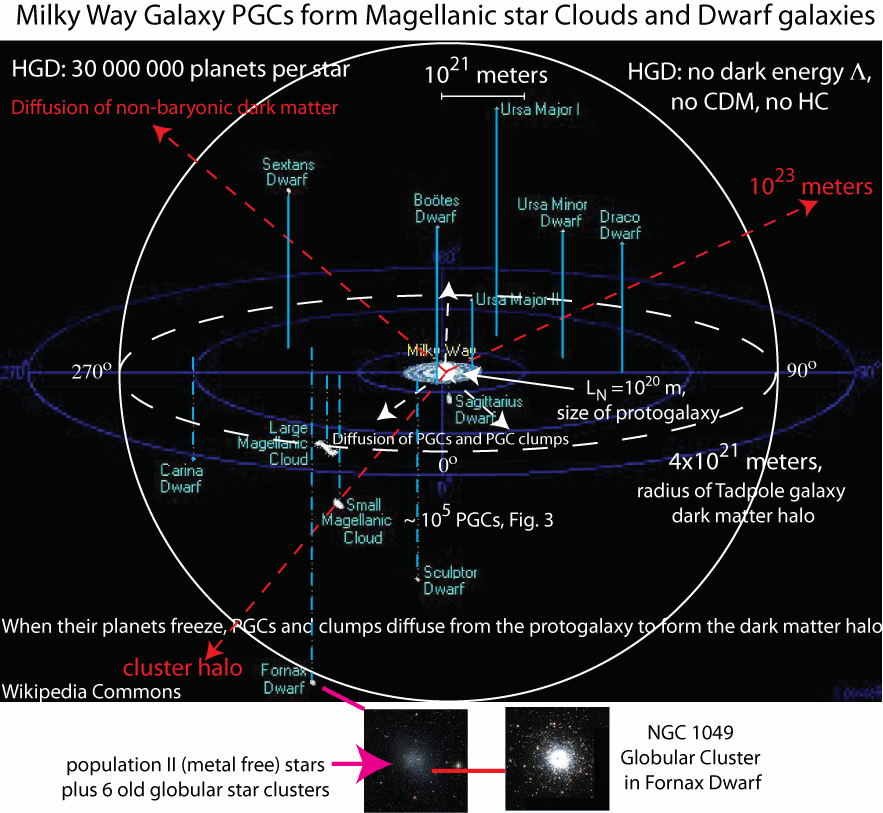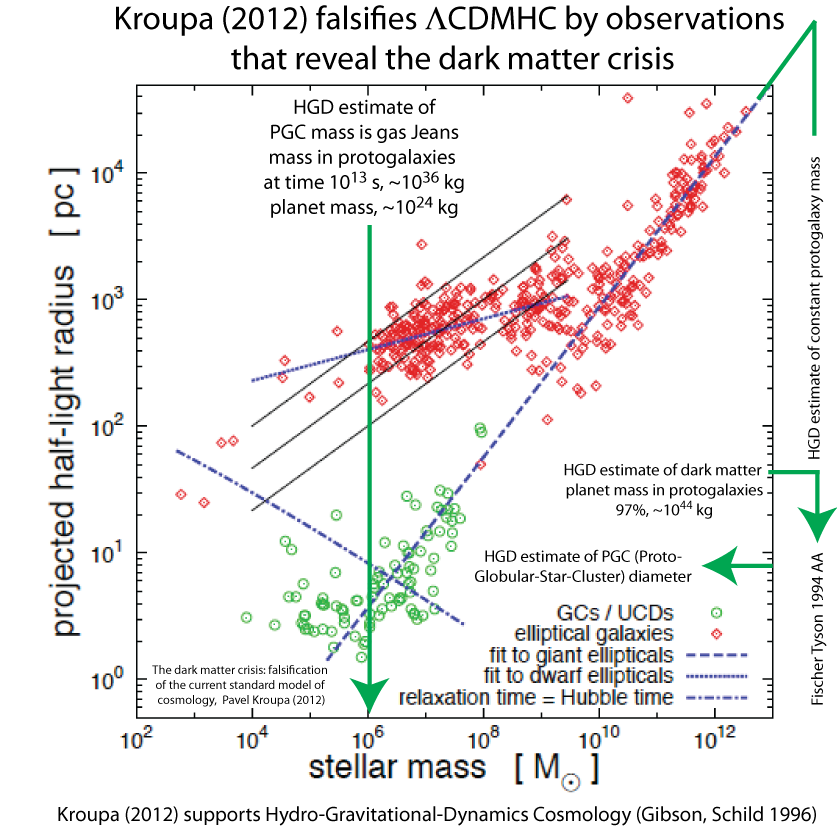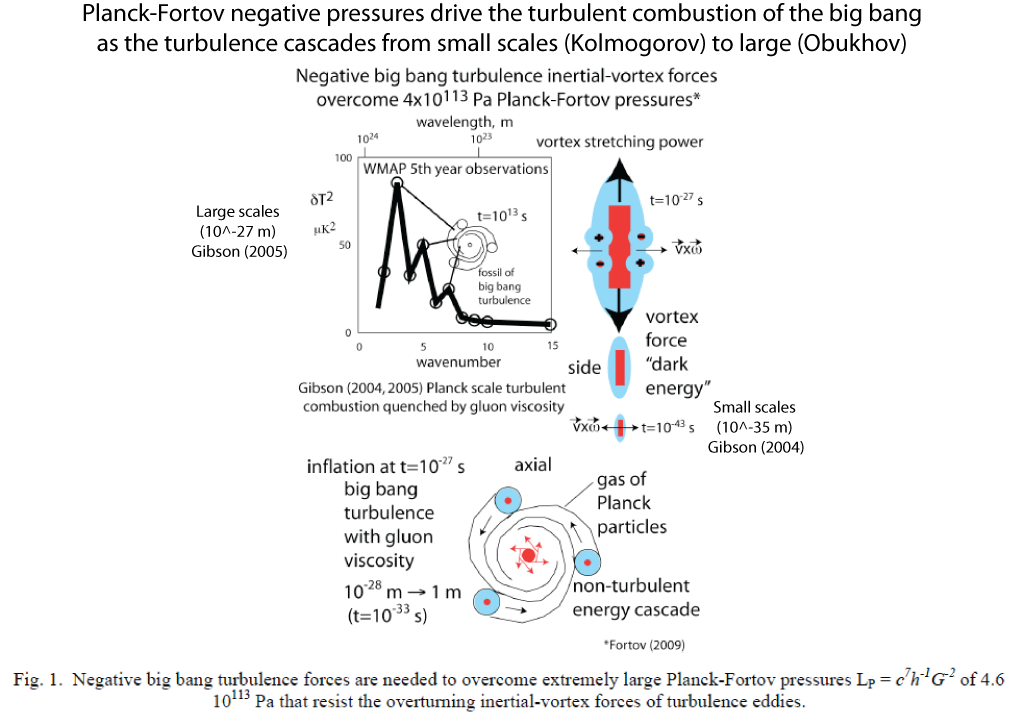
Baryonic Dark matter distribution in the Milky Way Galaxy from Herschel-Planck-Spitzer (Gibson 2012 Fig. 4)
EXTREME CONDITIONS ON EARTH, IN SPACE, AND IN TIME
Spring 2012 issue of Journal of Cosmology, Volume 18
Editors: Rudy E. Schild and Carl H. Gibson
Guest Editors: R. Norris Keeler and Vladimir Fortov
THE STRUCTURES OF THE UNIVERSE AND TERRESTRIAL MEASUREMENTS
Concordance Cosmology, or LCDMHC, explains the gravitational structures of the Universe based on simplifications of the fluid mechanics proposed by James Jeans in 1902. Observations from new space telescopes and improved telescopes on Earth suggest the 1902 Jeans simplifications must be corrected to include forces he neglected, like viscous stresses, and processes he neglected, like turbulence, fossil turbulence and fossil turbulence waves. Superdiffusivity and flavor changes of weakly collisional materials like neutrinos were completely unanticipated by Jeans, as well as the Planck-Kerr turbulence instability leading to the big bang at Planck length, time and temperature scales. Fortov-Planck pressures scale with light speed c, Planck constant h, and Newton's constant G, and must be large and negative, with values exceeding 10^113 Pa, to extract mass energy from the vacuum. Anti-gravity dark energy is not needed. L may not exist. Observations of microlensing and twinkling frequencies for a galaxy on the line of sight to a lensed quasar show the point mass objects that dominate the galaxy mass must be Earth mass planets, not stars, Schild (1996). This interpretation by Schild, that the missing mass of galaxies must be planets, confirms the independent Gibson (1996) prediction. According to hydrogravitational dynamics HGD cosmology, the dominant mass of galaxies is planets in Jeans mass clumps (Proto-Globular-starClusters, PGCs), in which all stars form by mergers of these primordial-gas planets. In this issue as in Volume 17 we suggest that HGD cosmology is supported by all observations and that LCDMHC is falsified. Both the accelerated expansion rate of the Universe and the antigravity dark energy (L) explanation are falsified. Faith in concordance cosmology is based on obsolete 19th century fluid mechanics, and is growing weaker with new observations (Kroupa 2012, I.1 below). The figure (Gibson 2012, Fig. 4, I.2 below, arXiv.1203.4437) summarizes the locations of PGCs in the Milky Way Galaxy based on Herschel space observatory, Planck, Spitzer etc. space telescope observations. The superdiffusive non-baryonic dark matter (red arrows) has diffused out of the Milky Way to form halos of clusters and halos of superclusters of galaxies. Once frozen, the PGC clumps of planets diffuse away from the central protogalaxy core (white arrows) with size 10^20 meters, termed the Nomura scale L_N. Mergers of the primordial gas planets to form larger planets and eventually stars reveal the PGCs at 14 K (as expected for frozen primordial gas planets as they evaporate to form larger planets and stars, since 13.8 K is the triple point temperature of hydrogen).
Commentary articles summarize the results of recent high energy particle experiments.
Terrestrial studies under extreme conditions most relevant to cosmology faced strong political restraints during the cold war, section II.
The Taylor-Lumley inverse cascade model of turbulence is falsified by theory, observations and numerical simulatons, section III.
New evidence of ancient life on Mars, section IV. Estimates of life transport rates from Venus during the transit event, section V.
CONTENTS
I. COSMOLOGY
1. The dark matter crisis: Falsification of the current standard model of cosmology - Pavel Kroupa (arXiv preprint). pp 7900-7950.

Figure JC2012.18.1.1 CHG. Kroupa (2012) measurements support HGD cosmology estimates of Proto-Globular-Star-Cluster (PGC) and Proto-Galaxy (PG) masses and sizes. For protogalaxies on the right of the figure, extrapolating the largest elliptical galaxies (red diamonds) matches the predicted HGD protogalaxy mass and the Fischer and Tyson 1994 measurement from the Sloan Survey that all galaxies weigh 10^44 kg. For globular clusters and "ultra-compact-dwarfs" UCDs and PGCs on the left, the extrapolation is to a million solar masses for the smallest galaxies, supporting HGD cosmology and Fig. 2 of Kroupa (2012).
2. Turbulence and Fossil Turbulence lead to Life in the Universe - Carl H. Gibson (Physica Scripta preprint for TMB 2011 Proceedings). pp 7951-7963.
3. Detector of Extreme Energy Cosmic Rays on Board Lomonosov Satellite - M.I. Panasyuk, B.A. Khrenov, G.K. Garipov et al. pp 7964-7977.
4. Gravitational Stability for a Vacuum Cosmic Space Crystalline Model - J. A. Montemayor-Aldrete, J. R. Morones-Ibarra, A. Morales-Mori, et al. pp 7978-7998.
5. Study of Early Universe Extreme Phenomena on Lomonosov Space Mission - V.A. Sadovnichii, M.I. Panasyuk, A.M. Amelushkin, V.V. Bogomolov, V.V. Bengin, A.Yu. Drozdov, G.K. Garipov, N.N. Kalmykov, P.A. Klimov, B.A. Khrenov, V.S. Morozenko, V.L. Petrov, S.A. Sharakin, A.V. Shirokov, S.I. Svertilov, N.N. Vedeníkin, and I.V. Yashin. pp 7999-8027.
6. Avoidance of Singularity in the Exterior of Spherically Symmetric Metric in C-field Cosmology - Raj Bali pp 8028-8058.
-
7. New Principle of Dynamical Relativity and Space-time Physical Picture - ChiYi Chen. pp 8059-8071.
8. Falsification of Dark Energy by Fluid Mechanics, Carl H. Gibson (preprint resubmitted to Journal of Fluid Mechanics 2012). pp 8072-8079.
Commentaries:
9. Fast Light, Fast Neutrinos? - Kevin Cahill. pp 8080.
10. Commentary on the OPERA Superluminal Neutrinos - Francis M. Sancheza & Valery A. Kotov. pp 8081-8083.
11. Extra Relativistic Effects? - B.G. Sidharth. pp 8084-8086.
12. Fast Neutrinos - Cynthia Kolb Whitney. pp 8087-8094.
II. EARLY STUDIES AND MEASUREMENTS UNDER EXTREME CONDITIONS
13. Matter Under Extreme Conditions: The Early Years - R. Norris Keeler and Carl H. Gibson. pp 8095-8104.
14. Extreme states of matter on Earth and in space - Vladimir E. Fortov (English version of 2009 paper, with the kind permission of the Russian Academy of Sciences). pp 8105-8138.

Figure JC2012.18.14.1 CHG. Inertial vortex forces vxw of big bang turbulent combustion at Panck-Fortov scales explain the huge negative pressures L_P of Einstein's cosmological constant and dark energy. The expression L_P ~ c^7 h^-1 G^-2 is derived by Academician Fortov. The fossil big bang turbulence signature is found at the largest scales of the cosmic microwave background by WMAP 5th year observations. This is Fig. 1 of Keeler-Gibson (2012, JofC, Vol. 18, No.13). The distinct signature of turbulence for plasma epoch scales is misidentified as baryon oscillations by LCDMHC cosmology. pp 8138.1.
15. L. V. Alítshuler, and High Energy Density Research - Carl H. Gibson, Nerses H. Krikorian and R. Norris Keeler, pp 8139-8171.
16. L. V. Alítshuler, Appendix of archived photographs - R. Norris Keeler and Carl H. Gibson. pp 8172-8190. Book review, R. Norris Keeler. pp 8191.
17. The Dynamic High Pressure work of Academician Ya. B. Zel'dovich (1914-1987) - Andre Kusubov and R. Norris Keeler. pp 8192-8199.
III. FLUID MECHANICS IN COSMOLOGY
18. What is turbulence, what is fossil turbulence, and which ways do they cascade? - Carl H. Gibson (preprint Journal of Fluid Mechanics 2012). pp 8200-8209.
IV. LIFE ON MARS
19. Discovery of Biological Structures in the Tissint Mars Meteorite - J. Wallis, N. C. Wickramasinghe, Daryl Wallis, Nori Miyake, Max Wallis, Barry Di Gregorio and Shirwan Al Mufti (accepted April 25, 2012), pp 8500-8505.
Commentaries (this paper claims to show life existed on ancient Mars, so comments are invited):
V. LIFE ON VENUS
20. A Note on Venus Transit and Microbial Injection to Earth - N. Chandra Wickramasinghe and Janaki T. Wickramasinghe (submitted June 5, accepted June 9, 2012), pp 8506-8510.
VI. Book Review Fundamental Questions of Practical Cosmology. Exploring the Realm of Galaxies, by
Yurij Baryshev, & Pekka Teerikorpi (Springer, Dordrecht), 2012. ISBN 978-94-007-2378-8. 332 pages. Martin Lopez-Corredoira. Front matter, back matter.
VII. Invited papers for "Frontiers of Quantum and Mesoscopic Thermodynamics", 25-30 July, Prague, Czech Republic
21. The Mass Function of Primordial Rogue Planet MACHOs in quasar nanolensing, Rudolph E. Schild, Theo M. Nieuwenhuizen and Carl H. Gibson, pp 8511-8524.
22. Formation of stars from dark matter clumps of primordial planets, Carl H. Gibson, Rudolph E. Schild, N. Chandra Wickramasinghe and Theo M. Nieuwenhuizen, pp 8525-8538.
23. WHY DONíT CLUMPS OF CIRRUS DUST GRAVITATIONALLY COLLAPSE?, Rudolph E. Schild, Carl H. Gibson, Theo M. Nieuwenhuizen, and N. Chandra Wickramasinghe, pp 8539-8546.